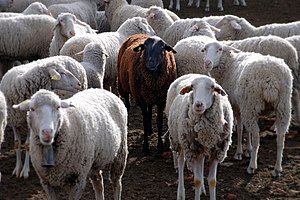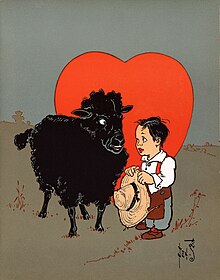Group dynamics is a system of behaviors and psychological processes occurring within a social group, or between social groups. The study of group dynamics can be useful in understanding decision-making behaviour, tracking the spread of diseases in society, creating effective therapy techniques, and following the emergence and popularity of new ideas and technologies. These applications of the field are studied in psychology, sociology, anthropology, political science, epidemiology, education, social work, leadership studies, business and managerial studies, as well as communication studies.
The out-group homogeneity effect is the perception of out-group members as more similar to one another than are in-group members, e.g. "they are alike; we are diverse". Perceivers tend to have impressions about the diversity or variability of group members around those central tendencies or typical attributes of those group members. Thus, outgroup stereotypicality judgments are overestimated, supporting the view that out-group stereotypes are overgeneralizations. The term "outgroup homogeneity effect", "outgroup homogeneity bias" or "relative outgroup homogeneity" have been explicitly contrasted with "outgroup homogeneity" in general, the latter referring to perceived outgroup variability unrelated to perceptions of the ingroup.
In-group favoritism, sometimes known as in-group–out-group bias, in-group bias, intergroup bias, or in-group preference, is a pattern of favoring members of one's in-group over out-group members. This can be expressed in evaluation of others, in allocation of resources, and in many other ways.

In social psychology and sociology, an in-group is a social group to which a person psychologically identifies as being a member. By contrast, an out-group is a social group with which an individual does not identify. People may for example identify with their peer group, family, community, sports team, political party, gender, sexual orientation, religion, or nation. It has been found that the psychological membership of social groups and categories is associated with a wide variety of phenomena.
In psychology and other social sciences, the contact hypothesis suggests that intergroup contact under appropriate conditions can effectively reduce prejudice between majority and minority group members. Following WWII and the desegregation of the military and other public institutions, policymakers and social scientists had turned an eye towards the policy implications of interracial contact. Of them, social psychologist Gordon Allport united early research in this vein under intergroup contact theory.
Social identity is the portion of an individual's self-concept derived from perceived membership in a relevant social group.
Infrahumanisation is the tacitly held belief that one's ingroup is more human than an outgroup, which is less human. The term was coined by Jacques-Philippe Leyens and colleagues in the early 2000s to distinguish what they argue to be an everyday phenomenon from dehumanisation associated with extreme intergroup violence such as genocide. According to Leyens and colleagues, infrahumanisation arises when people view their ingroup and outgroup as essentially different and accordingly reserve the "human essence" for the ingroup and deny it to the outgroup. Whether a "subhuman" classification means "human but inferior" or "not human at all" may be academic, as in practice it corresponds to prejudice regardless.
Realistic conflict theory (RCT), also known as realistic group conflict theory (RGCT), is a social psychological model of intergroup conflict. The theory explains how intergroup hostility can arise as a result of conflicting goals and competition over limited resources, and it also offers an explanation for the feelings of prejudice and discrimination toward the outgroup that accompany the intergroup hostility. Groups may be in competition for a real or perceived scarcity of resources such as money, political power, military protection, or social status.
Self-categorization theory is a theory in social psychology that describes the circumstances under which a person will perceive collections of people as a group, as well as the consequences of perceiving people in group terms. Although the theory is often introduced as an explanation of psychological group formation, it is more accurately thought of as general analysis of the functioning of categorization processes in social perception and interaction that speaks to issues of individual identity as much as group phenomena. It was developed by John Turner and colleagues, and along with social identity theory it is a constituent part of the social identity approach. It was in part developed to address questions that arose in response to social identity theory about the mechanistic underpinnings of social identification.

In social psychology, a stereotype is a generalized belief about a particular category of people. It is an expectation that people might have about every person of a particular group. The type of expectation can vary; it can be, for example, an expectation about the group's personality, preferences, appearance or ability. Stereotypes are often overgeneralized, inaccurate, and resistant to new information. A stereotype does not necessarily need to be a negative assumption. They may be positive, neutral, or negative.
The ultimate attribution error is a type of attribution error which describes how attributions of outgroup behavior are more negative than ingroup behavior. As a cognitive bias, the error results in negative outgroup behavior being more likely to be attributed to factors internal and specific to the actor, such as personality, and the attribution of negative ingroup behavior to external factors such as luck or circumstance. The bias reinforces negative stereotypes and prejudice about the outgroup and favouritism of the ingroup through positive stereotypes. The theory also extends to the bias that positive acts performed by ingroup members are more likely a result of their personality.

Amélie Mummendey was a German social psychologist. From 2007 until her death, she was a Vice-Rector for the Graduate Academy at the Friedrich Schiller University Jena.
Linguistic Intergroup Bias is a term coined by Anne Maass to describe a type of language bias which can perpetuate stereotypes. The model is based on the idea that people tend to use abstract language to describe actions which they believe to be stereotypical of a certain group, and concrete language to describe unusual or uncharacteristic behavior. Both relate to beliefs about the agent’s intrinsic nature or character. A positive action by someone you don't like, for instance, would tend to be described in concrete terms, because you regard it as uncharacteristic, while a negative action would be abstract, because you view it as typical. The reverse is true for people you do like. A positive action would be described in abstract terms because you would regard it as characteristic, and concrete if it is not. Using these different levels of linguistic abstraction serves to maintain a positive in-group bias and a negative out-group bias.
Intergroup anxiety is the social phenomenon identified by Walter and Cookie Stephan in 1985 that describes the ambiguous feelings of discomfort or anxiety when interacting with members of other groups. Such emotions also constitute intergroup anxiety when one is merely anticipating interaction with members of an outgroup. Expectations that interactions with foreign members of outgroups will result in an aversive experience is believed to be the cause of intergroup anxiety, with an affected individual being anxious or unsure about a number of issues. Methods of reducing intergroup anxiety and stress including facilitating positive intergroup contact.
The common ingroup identity model is a theoretical model proposed by Samuel L. Gaertner and John F. Dovidio that outlines the processes through which intergroup bias may be reduced. Intergroup bias is a preference for one's in-group over the out-group. Derived from the social identity approach to intergroup behaviour, the common ingroup identity model is rooted in the process of social categorization, or how people conceive of group boundaries. The model describes how intergroup bias can be reduced if members of different groups can be induced to conceive of themselves to be part of the same group, then they would develop more positive attitudes of the former outgroup members. An individual will change the way they view the out-group through a social categorization process called recategorization where former out-group members become incorporated into individual's representations of the in-group.
In social psychology, a metastereotype is a stereotype that members of one group have about the way in which they are stereotypically viewed by members of another group. In other words, it is a stereotype about a stereotype. They have been shown to have adverse effects on individuals that hold them, including on their levels of anxiety in interracial conversations. Meta-stereotypes held by African Americans regarding the stereotypes White Americans have about them have been found to be largely both negative and accurate. People portray meta-stereotypes of their ingroup more positively when talking to a member of an outgroup than to a fellow member of their ingroup.
Diversity ideology refers to individual beliefs regarding the nature of intergroup relations and how to improve them in culturally diverse societies. A large amount of scientific literature in social psychology studies diversity ideologies as prejudice reduction strategies, most commonly in the context of racial groups and interracial interactions. In research studies on the effects of diversity ideology, social psychologists have either examined endorsement of a diversity ideology as individual difference or used situational priming designs to activate the mindset of a particular diversity ideology. It is consistently shown that diversity ideologies influence how individuals perceive, judge and treat cultural outgroup members. Different diversity ideologies are associated with distinct effects on intergroup relations, such as stereotyping and prejudice, intergroup equality, and intergroup interactions from the perspectives of both majority and minority group members. Beyond intergroup consequences, diversity ideology also has implications on individual outcomes, such as whether people are open to cultural fusion and foreign ideas, which in turn predict creativity.
In social psychology, social projection is the psychological process through which an individual expects behaviors or attitudes of others to be similar to their own. Social projection occurs between individuals as well as across ingroup and outgroup contexts in a variety of domains. Research has shown that aspects of social categorization affect the extent to which social projection occurs. Cognitive and motivational approaches have been used to understand the psychological underpinnings of social projection as a phenomenon. Cognitive approaches emphasize social projection as a heuristic, while motivational approaches contextualize social projection as a means to feel connected to others. In contemporary research on social projection, researchers work to further distinguish between the effects of social projection and self-stereotyping on the individual’s perception of others.
An empathy gap, sometimes referred to as an empathy bias, is a breakdown or reduction in empathy where it might otherwise be expected to occur. Empathy gaps may occur due to a failure in the process of empathizing or as a consequence of stable personality characteristics, and may reflect either a lack of ability or motivation to empathize.
Social identity threat is a theory in social psychology derived from social identity theory to explain the different types of threats that arise from group identity being threatened as opposed to personal identity. This theory distinguishes between four distinct types of social identity threats: categorization threat, distinctiveness threat, threats to the value of social identity, and acceptance threat. Each type is associated with particular social contexts that make the threats more or less likely to occur. This theory emphasizes how the level of commitment with the social identity shapes the nature of the threat experienced.





